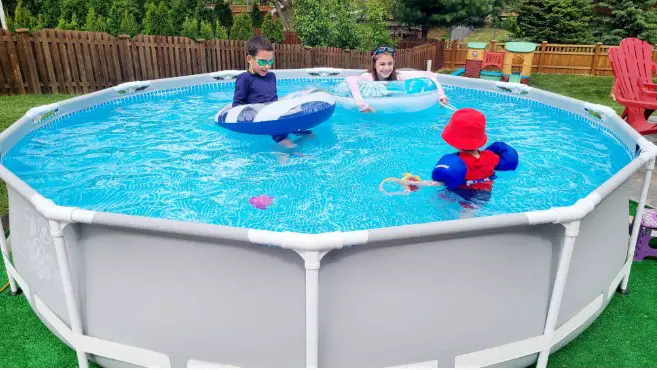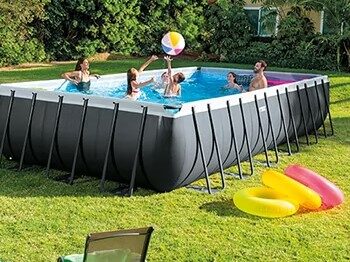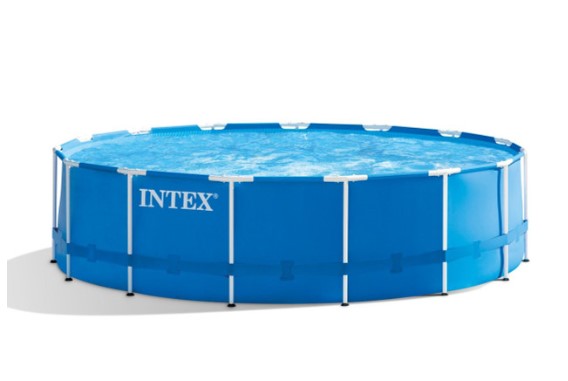Table of Contents
Summer has arrived, and there’s nothing quite like enjoying a nice, refreshing dip in your Intex pool.
But if you’ve noticed the water level dropping more rapidly than expected or constantly find yourself topping off the pool, it’s time to consider if your pool might be leaking.
Fortunately, identifying and fixing leaks in your Intex pool can be a fairly straightforward process.
A leaking Intex pool not only wastes water but can also lead to more significant issues, such as damage to your lawn or surrounding structures.
In this article, we’ll walk through some easy-to-follow steps that can help you determine whether your pool is indeed leaking and how to pinpoint the source of the problem.
Before you begin, it’s essential to rule out factors such as evaporation or splashing as the cause of your pool’s water loss.
Once you’ve considered these possibilities, we can delve into several methods for accurately detecting a leak in your pool and its location. Don’t worry; we’ll guide you every step of the way!
Identifying Potential Leak Signs
Unusual Water Loss
One of the first signs to look for when trying to determine if your Intex pool is leaking is a sudden decrease in water level. While some water loss is expected due to evaporation, this should be minimal and consistent. If you notice your pool losing more water than usual, it could indicate a leak.
Wet Areas Around the Pool
Are there puddles or damp patches on the ground around your Intex pool? This could be another sign indicating a leak. Evaporation alone should not cause excessively wet areas around the pool.
High Water Bills
If you experience a sudden surge in your water bill without any changes to your water usage habits, this should raise suspicion. A leaking pool will require constant refilling, thus increasing your water bill significantly.
| Water Loss | Water Bill |
|---|---|
| Limited | Normal |
| Significant | High |
Algae Growth
Uncontrolled algae growth inside your Intex pool could be another indicator of a leak. While algae growth can be the result of multiple factors, it often occurs when chemical levels are off-balance due to constant water loss and replacement.
Chemical Imbalances
A leaking pool affects the balance of chemicals in the water. Too much water loss can lead to imbalances in the pool’s pH, alkalinity, and chlorine levels. If you find yourself needing to adjust your pool chemicals more often than usual, a leaking pool could be the root cause.
- Less water loss: Consistent chemical levels
- More water loss: Frequent adjustments needed
Performing a Bucket Test
To determine if your Intex pool is leaking, you can perform a simple bucket test.
This test will help you detect if there’s a significant difference in the water level between your pool and a container of water.
First, grab a bucket or a similar-sized container and place it on the pool step or any elevated surface inside your Intex pool.
Ensure that the bucket’s edges are above the waterline of the pool to prevent water from entering the bucket itself.
Next, fill the bucket with pool water and use a waterproof marker to mark the water level inside the bucket.
Simultaneously, mark the pool water level on the outside of the bucket. This will enable you to compare the water levels in both the bucket and the pool.
Allow the bucket and the pool to sit undisturbed for 24 to 48 hours. During this time, avoid swimming or any other activities that could cause water displacement in the pool.
Ideally, perform the test when the temperature is consistent, as fluctuations may affect the rate of evaporation.
After the waiting period, check the water levels in the bucket and compare them to the initial markings. Here are the possible results:
- If both water levels decreased by the same amount, it’s most likely due to evaporation, and there’s likely no leak.
- If the pool water level decreased significantly more than the bucket’s water level, your Intex pool may have a leak.
Remember that performing a bucket test isn’t a foolproof method for detecting leaks, but it’s a great starting point.
If you’re unsure or suspect a leak, consider contacting a pool professional for further assistance.
Inspecting the Intex Pool
Examine the Pool Liner
Start by examining the pool liner of your Intex pool, whether it is a round pool or an above-ground pool. Look for any tears, holes or cracks that could be causing a pool leak. Focus on high-stress areas such as corners and the base, as these parts are more prone to damage. To effectively detect a leak:
- Fill the pool with water to its recommended level.
- Walk around the pool, carefully inspecting the entire liner.
- If you notice any wet spots on the ground, this may indicate a leak in the liner.
Check the Pool Skimmer and Returns
Skimmer leaks and return line leaks are common in Intex pools. To check for these issues:
- Examine the skimmer for cracks and corrosion.
- Inspect the valves, plugs, and o-rings on the returns and skimmers for signs of wear.
- If you suspect a leak, pour a small amount of food color near the suspected area while your pump and filter are turned off. Observe if the food color flows towards the leak.
Assess the Pool Lights
Pool lights may also be a source of leaks. To inspect the lights, follow these steps:
- Turn off the pool lights for safety.
- Examine the light’s gasket and housing for any signs of wear, cracks or corrosion.
- Check the surrounding areas for wet spots or other signs of leaks.
If you find any issues, consider using pool putty, silicone, or caulk to seal the light leaks temporarily.
Evaluate the Pool Equipment and Plumbing
Finally, check your Intex pool’s equipment and plumbing system for leaks. Inspect the equipment pad (including pump, heater, and filter), underground pipes, fittings, and hoses. Signs of potential leaks can include:
- Water pooling around the equipment pad.
- Damp patches or wet spots in the surrounding ground.
- Noticeable changes in water pressure.
Keep in mind that some possible leaks may be hard to detect, as they could be pressurized or underground. If you suspect a plumbing leak but cannot locate it, consider contacting a pool leak detection specialist.
When you’ve identified the leak source, use an appropriate pool repair method, such as a repair kit or adhesive, to fix the issue as soon as possible. Regular maintenance and inspection of your Intex pool will help prevent leaks and extend the lifespan of your pool.
Confirming and Repairing the Leak
Using Food Coloring to Pinpoint Leaks
One common method to find a leak in a pool is using food coloring. To do this, you will need:
- Food coloring
- A syringe or dropper
- Goggles
- Turn off the pool pump and make sure the water is still.
- Put on your goggles and carefully observe the area where you suspect the leak is located.
- Using the syringe or dropper, slowly release the food coloring near the suspected leak.
- Watch to see if the food coloring is drawn into the leak. If so, you’ve found the leak location!
Consulting a Pool Service Company
If you’re unsure about the source of a leak or how to repair it, consider consulting a pool service company. They can:
- Inspect the pool and find the leak.
- Recommend the appropriate repair.
- Provide advice on maintaining good pool chemistry.
- Assist with backwashing, which reduces debris and maintains proper water flow.
DIY Pool Leak Repairs
For minor leaks, you can try some DIY repair options. These include:
- Pool putty: A moldable, adhesive substance used to seal small leaks. Make sure the area is clean and dry before applying.
- Adhesive patch: For leaks in the pool liner, clean and dry the area, then apply the adhesive patch.
Remember to always consult your pool manufacturer’s guidelines and take safety precautions when working with pool chemicals.
Preventing Future Leaks
Regular Pool Maintenance
Regular pool maintenance goes a long way in preventing Intex pool leaks. Here are some things you should focus on:
- Check your pump and filter system regularly. Make sure they are functioning correctly to avoid any water level issues.
- Clean your above-ground pool’s drain to remove debris that may cause blockages and leaks.
- Consider hiring a professional pool service company to perform routine maintenance, especially if you are unsure about the process. They can spot potential problems and fix them before they escalate.
Addressing Wet Areas and Erosion
Detecting and addressing wet areas and erosion around your Intex pool is essential to prevent future leaks. Follow these steps:
- Regularly inspect the area around your pool for any signs of wetness, as this may indicate a leak.
- Mark any suspicious wet spots around your pool using a marker. Keep an eye on these areas to see if they grow larger or if water continues to accumulate.
- If erosion is present, you may need to add more supports to your round pool or seek professional assistance.
- Address wet areas by draining the pool partially and patching any visible leaks before they worsen.
By maintaining your Intex pool regularly and addressing wet areas and erosion, you can prevent future leaks and extend the lifespan of your pool.



